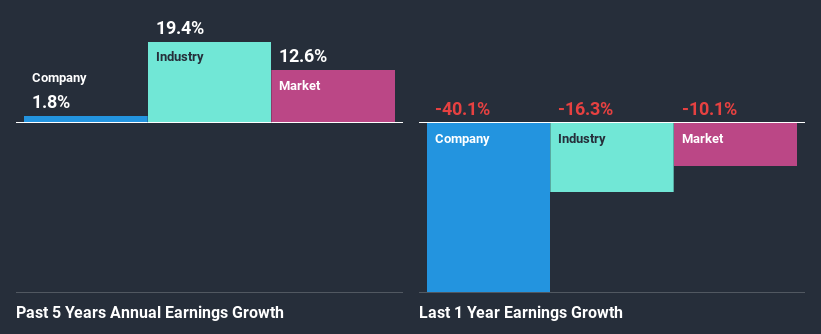- India
- /
- Trade Distributors
- /
- NSEI:VINYLINDIA
Is Vinyl Chemicals (India) Limited's (NSE:VINYLINDIA) Recent Price Movement Underpinned By Its Weak Fundamentals?

It is hard to get excited after looking at Vinyl Chemicals (India)'s (NSE:VINYLINDIA) recent performance, when its stock has declined 4.5% over the past three months. We, however decided to study the company's financials to determine if they have got anything to do with the price decline. Fundamentals usually dictate market outcomes so it makes sense to study the company's financials. In this article, we decided to focus on Vinyl Chemicals (India)'s ROE.
Return on equity or ROE is a key measure used to assess how efficiently a company's management is utilizing the company's capital. In other words, it is a profitability ratio which measures the rate of return on the capital provided by the company's shareholders.
See our latest analysis for Vinyl Chemicals (India)
How To Calculate Return On Equity?
Return on equity can be calculated by using the formula:
Return on Equity = Net Profit (from continuing operations) ÷ Shareholders' Equity
So, based on the above formula, the ROE for Vinyl Chemicals (India) is:
11% = ₹68m ÷ ₹594m (Based on the trailing twelve months to September 2020).
The 'return' is the income the business earned over the last year. So, this means that for every ₹1 of its shareholder's investments, the company generates a profit of ₹0.11.
What Is The Relationship Between ROE And Earnings Growth?
So far, we've learned that ROE is a measure of a company's profitability. Depending on how much of these profits the company reinvests or "retains", and how effectively it does so, we are then able to assess a company’s earnings growth potential. Assuming all else is equal, companies that have both a higher return on equity and higher profit retention are usually the ones that have a higher growth rate when compared to companies that don't have the same features.
Vinyl Chemicals (India)'s Earnings Growth And 11% ROE
At first glance, Vinyl Chemicals (India)'s ROE doesn't look very promising. Although a closer study shows that the company's ROE is higher than the industry average of 4.4% which we definitely can't overlook. However, Vinyl Chemicals (India) has seen a flattish net income growth over the past five years, which is not saying much. Remember, the company's ROE is a bit low to begin with, just that it is higher than the industry average. Hence, this goes some way in explaining the flat earnings growth.
We then compared Vinyl Chemicals (India)'s net income growth with the industry and found that the company's growth figure is lower than the average industry growth rate of 19% in the same period, which is a bit concerning.

Earnings growth is an important metric to consider when valuing a stock. The investor should try to establish if the expected growth or decline in earnings, whichever the case may be, is priced in. This then helps them determine if the stock is placed for a bright or bleak future. One good indicator of expected earnings growth is the P/E ratio which determines the price the market is willing to pay for a stock based on its earnings prospects. So, you may want to check if Vinyl Chemicals (India) is trading on a high P/E or a low P/E, relative to its industry.
Is Vinyl Chemicals (India) Making Efficient Use Of Its Profits?
The high three-year median payout ratio of 54% (meaning, the company retains only 46% of profits) for Vinyl Chemicals (India) suggests that the company's earnings growth was miniscule as a result of paying out a majority of its earnings.
Additionally, Vinyl Chemicals (India) has paid dividends over a period of at least ten years, which means that the company's management is determined to pay dividends even if it means little to no earnings growth.
Conclusion
In total, we're a bit ambivalent about Vinyl Chemicals (India)'s performance. Specifically, the low earnings growth is a bit concerning, especially given that the company has a respectable rate of return. Investors may have benefitted, had the company been reinvesting more of its earnings. As discussed earlier, the company is retaining a small portion of its profits. Up till now, we've only made a short study of the company's growth data. You can do your own research on Vinyl Chemicals (India) and see how it has performed in the past by looking at this FREE detailed graph of past earnings, revenue and cash flows.
When trading Vinyl Chemicals (India) or any other investment, use the platform considered by many to be the Professional's Gateway to the Worlds Market, Interactive Brokers. You get the lowest-cost* trading on stocks, options, futures, forex, bonds and funds worldwide from a single integrated account. Promoted
New: Manage All Your Stock Portfolios in One Place
We've created the ultimate portfolio companion for stock investors, and it's free.
• Connect an unlimited number of Portfolios and see your total in one currency
• Be alerted to new Warning Signs or Risks via email or mobile
• Track the Fair Value of your stocks
This article by Simply Wall St is general in nature. It does not constitute a recommendation to buy or sell any stock, and does not take account of your objectives, or your financial situation. We aim to bring you long-term focused analysis driven by fundamental data. Note that our analysis may not factor in the latest price-sensitive company announcements or qualitative material. Simply Wall St has no position in any stocks mentioned.
*Interactive Brokers Rated Lowest Cost Broker by StockBrokers.com Annual Online Review 2020
Have feedback on this article? Concerned about the content? Get in touch with us directly. Alternatively, email editorial-team@simplywallst.com.
About NSEI:VINYLINDIA
Flawless balance sheet established dividend payer.
Similar Companies
Market Insights
Community Narratives




